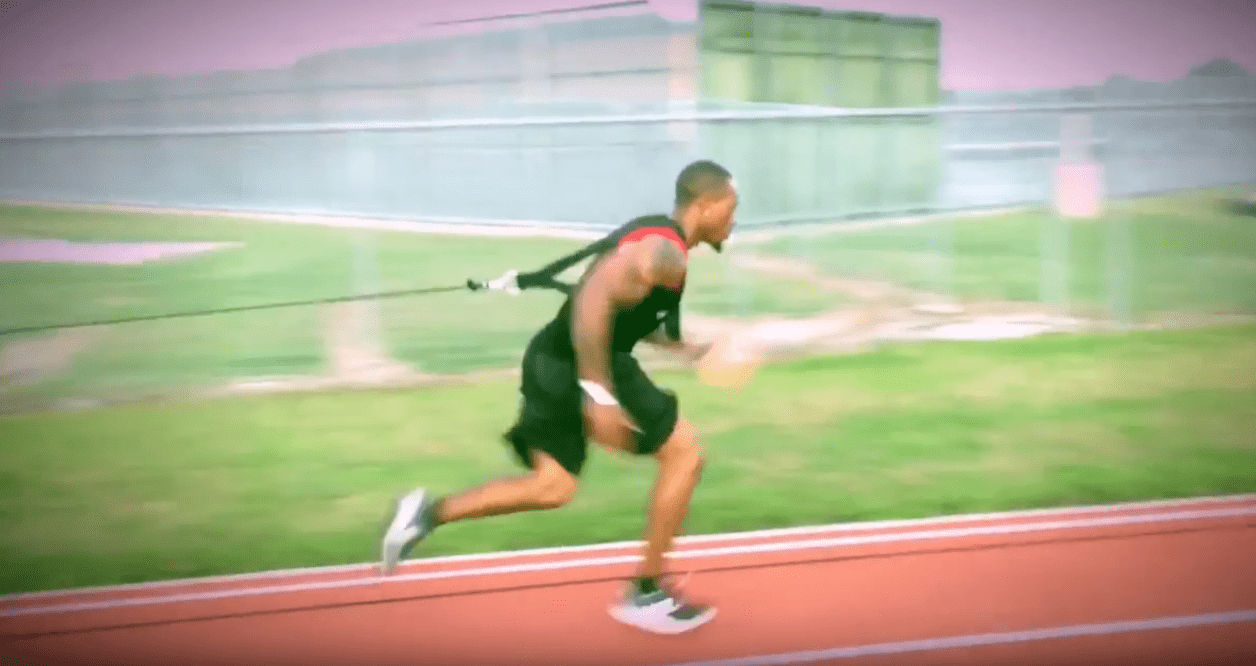There are a few different types of equipment that can be used to generate variable but constant horizontal resistance in sprint training, but some popular options include:
- Resistance bands: There are flexible – therefore not constant resistance generating – bands that come in a variety of sizes and levels of resistance. The variable and constant resistance of the inflexible band of the Exer-Genie is determined by the stopping power created within the cylindrical part of the system. Flexible and non-flexible bands can be attached to a stationary object, such as a pole or a wall, and used for exercises that target the legs, hips, and core.
- Sleds: Sleds are weighted platforms that can be pushed or pulled along a surface. They can be used to generate horizontal resistance during sprint training, and the resistance can be adjusted by adding or removing weight.
- Parachutes: These are large, circular devices that attach to an athlete’s waist and create resistance as they run. The resistance can be adjusted by adjusting the size of the parachute or by changing the wind conditions.
- Treadmill: Treadmills with incline function can be used to generate horizontal resistance as well as vertical resistance, this can be done by running at a certain incline and speed. This can help to improve explosiveness, endurance, and overall power.
Ultimately, the best equipment for generating variable but constant horizontal resistance in sprint training will depend on the specific goals and needs of the athlete, as well as the resources available to them.
The best way to train speed and strength with horizontal resistance is through a combination of plyometric exercises and resistance band training. Plyometrics, such as box jumps and bounding, can help improve power and explosiveness, while resistance band training can help build strength and muscle mass. It’s also important to include a dynamic warm-up and cool-down and to progressively increase the resistance and intensity of the exercises over time. Additionally, incorporating sport-specific movements, such as sprinting or jumping, can help transfer the improvements in speed and strength to the specific sport or activity.
Strongmen often use horizontal resistance to get stronger through a variety of exercises, such as farmer’s walks, yoke walks, and sled pushes.
Farmer’s walks involve carrying heavy weights, such as kettlebells or dumbbells, at your sides while walking for a certain distance or time. This exercise works the grip, upper back, and core, as well as the legs.
Yoke walks involve carrying a heavy barbell or yoke on your shoulders and walking for a certain distance or time. This exercise works the legs, back, and core, as well as the grip.
Sled pushes involve pushing a loaded sled for a certain distance or time. This exercise works the legs, back and core, as well as the shoulders and arms.
These exercises are very effective in building strength, power, endurance and muscle mass. To get the best results, they should be performed with proper form and at a challenging weight, and gradually increase the weight and distance over time.
Proper form in sprinting and truck pulling is crucial in order to maximize power, efficiency, and injury prevention.
Sprinting:
- Head and eyes should be forward, not looking down at the ground.
- Shoulders should be back and relaxed, not hunched forward.
- Arms should swing forward and back, not across the body.
- Hands should be relaxed and open, not clenched into fists.
- The trunk should be held in a stable, upright position.
- Knees should be lifted high and drive forward, not out to the side.
- Feet should land on the balls of the feet, not the heel.
- Push off the ground with the toes, not the heel.
- Keep the back leg straight, not hyperextended.
Truck Pulling:
- Start with a wide stance, with the feet about shoulder-width apart.
- Keep your chest up and shoulders back, with a slight bend in the knees.
- Keep the back straight, core engaged, and the glutes tight.
- Keep your head up and look forward.
- As you begin to pull, keep your arms straight and drive through your heels.
- Use your legs and hips to generate power and pull the truck towards you.
- Keep your grip firm and avoid twisting your wrists.
- As you get closer to the truck, you can bend your knees more and use your back muscles to finish the pull.
- Keep your arms straight and your back flat until the end.
The frequency of incorporating horizontal resistance training for speed and strength in your training routine will depend on your goals, fitness level, and recovery ability.
If your goal is to primarily improve speed, it’s recommended to include plyometrics and resisted sprints at least 2-3 times per week. These exercises should be performed at maximum intensity and with proper form, so it’s important to have adequate recovery time between sessions.
If your goal is to primarily improve strength, it’s recommended to include exercises such as farmer’s walks, yoke walks, and sled pushes 2-3 times per week. These exercises can be heavy, so it’s important to have adequate recovery time between sessions and to progressively increase the weight and distance over time.
If your goal is to improve both speed and strength, you can alternate between plyometrics and resistance band training on one day, and farmer’s walks, yoke walks, and sled pushes on another day, or include both in the same session.
It’s important to remember that recovery and rest are also important, so make sure you are getting enough rest and adequate sleep, and listen to your body if it is feeling fatigued or overworked. A coach or trainer can help you design a training program that is tailored to your specific goals and fitness level.
